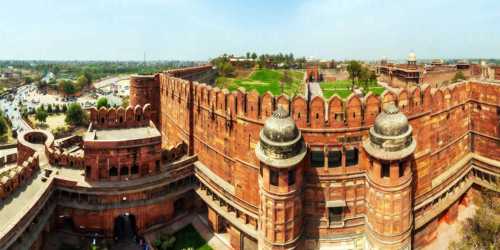Agra Fort (also called Red Fort) is a historical fort in the city of Agra in India. It is the large 16th-century fortress of red sandstone located on the Yamuna River in the historic city of Agra, west-central Uttar Pradesh, north-central India. It was the main residence of the emperors of the Mughal Dynasty until 1638 when the capital was shifted from Agra to Delhi. Before capture by the British, the last Indian rulers to have occupied it were the Marathas. In 1983, the Agra fort was inscribed as a UNESCO World Heritage Site. It is about 2.5 km northwest of its more famous sister monument, the Taj Mahal. The fort can be more accurately described as a walled city.
It was established by the Mughal emperor Akbar and, in its capacity as both a military base and a royal residence, served as the seat of government when the Mughal capital was in Agra. The structure, a contemporary of Humāyūn’s Tomb in Delhi (about 125 miles (200 km) to the northwest), reflects the architectural grandeur of the Mughal reign in India.
It took more than 4000 workers and eight years of hardship to complete the fort. Knowing the significance of its location, Akbar built the fort to make it the main residence of the Mughals. The fort remained as the main residence of the emperors belonging to the Mughal dynasty until the year 1638. The fort houses numerous impressive structures like the Jahangir Mahal, Khas Mahal, Diwan-i-Khass, Diwan-i-Am, Machchhi Bhawan, and Moti Masjid.
It had been used by the early Mughal rulers. The Fort stands on an ancient site and was traditionally known as Badalgarh. It was captured by Ghaznavi for some time but in the 15th century A.D., the Chauhan Rajputs occupied it. Soon after, Agra assumed the status of capital when Sikandar Lodi (A.D. 1487–1517) shifted his capital from Delhi and constructed a few buildings in the pre-existing Fort at Agra. After the first battle of Panipat (A.D. 1526) Mughals captured the fort and ruled from it. In A.D. 1530, Humayun was crowned in it. The Fort got its present appearance during the reign of Akbar (A.D. 1556–1605).

History of the Fort –
Agra Fort is known for its rich history. The fort has been owned by many emperors and rulers in the past, undergoing many changes in its appearance. It all began in the year 1526 when the first battle of Panipat was fought between Babur and Ibrahim Lodi of the Lodi dynasty. When Babur defeated Ibrahim Lodi, he made the fort and the palace of Ibrahim Lodi as his home. He then modified the fort by building a huge stepwell (baoli) inside. The fort soon became an important monument to the Mughals. In fact, Babur’s successor, Humayun’s coronation took place at the fort in the year 1530.
Soon emperors from other dynasties started eyeing the fort and efforts to win over the same began. In 1540, Sher Shah Suri of the Sur Empire waged a war against Humayun and defeated him at Bilgram. Sher Shah Suri took over the ownership of the fort from Humayun and made minor changes to it, so as to suit his own architectural taste. The fort stayed with the emperors of the Sur dynasty for the next 15 years.
The fort remained with the Suris till 1555, when Humayun recaptured it. Adil Shah Suri’s general, Hemu, recaptured Agra in 1556 and pursued its fleeing governor to Delhi where he met the Mughals in the Battle of Tughlaqabad. Realizing the importance of its central situation, Akbar made it his capital and arrived in Agra in 1558. His historian, Abul Fazl, recorded that this was a brick fort known as ‘Badalgarh’. It was in a ruined condition and Akbar had it rebuilt with red sandstone from Barauli area Dhaulpur district, in Rajasthan. Architects laid the foundation and it was built with bricks in the inner core with sandstone on external surfaces. Some 4,000 builders worked on it daily for eight years, completing it in 1573.
During the reign of Shah Jahan, the fort was modified considerably and took the current form. Shah Jahan destroyed some of the edifices within the fort and rebuilt it as per his own architectural taste. During the early 17th century, the fort was captured by the Maratha Empire. During this period, the fort saw many owners including various Maratha emperors and their enemies which included a host of Mughal emperors.
In 1761, the Marathas underwent a massive defeat at the hands of Ahmad Shah Durrani, founder of the Durrani Empire. The emperors of the Durrani dynasty made the fort their home until 1785. In 1785, the fort was regained by the Marathas under the reign of Mahadji Shinde. The Marathas then lost their battle against the British in the Second Anglo-Maratha War and with it the fort. The British then enjoyed the comfort of the fort until it was handed over to the government of India in 1947.

Architecture –
Situated on the site of earlier fortifications, it lies on the right bank of the Yamuna River and is connected to another of Agra’s renowned monuments, the Taj Mahal (downstream, around a bend in the Yamuna), by a swath of parkland and gardens. The fort was commissioned by Akbar in 1565 and reportedly took eight years to construct. The walls of the roughly crescent-shaped structure have a circumference of about 1.5 miles (2.5 km), rise 70 feet (21 meters) high, and are surrounded by a moat. There are two access points in the walls: the Amar Singh Gate facing south (now the only means in or out of the fort complex) and the Delhi Gate facing west, the original entrance, which is richly decorated with intricate marble inlays. Many structures within the walls were added later by subsequent Mughal emperors, notably Shah Jahān and Jahāngīr. The complex of buildings reminiscent of Persian and Timurid-style architectural features forms a city within a city.
The fort has various palaces and halls. Among the palaces, the prominent ones are Macchi Bhavan, Khas Mahal, and Shah Jahani Mahal. The Amar Singh gate leads to the courtyard. The magnificent Diwan-I-Am (Hall of Public Audience) is on the right-hand side. A little further lay the royal pavilions, which houses the famous Nagina Masjid and Mina Masjid. The fort also has royal baths made out of marbles, which were used by the princesses. Also, places of worship and a private market place for the ladies were built within the fort. At the base of the fort, a secret passage was dug in an attempt to access it with ease, during times of emergency. Other attractions of the fort include a grape garden, a jasmine tower, a mirror palace (Shish Mahal), courtrooms, and the ruins of Akbar’s once magnificent palace. It is said that the fort once housed five hundred beautiful looking buildings. Unfortunately, many of those buildings were destroyed at different time periods for various reasons.
The site is very important in terms of architectural history. Abul Fazal recorded that five hundred buildings in the beautiful designs of Bengal and Gujarat were built in the fort. Some of them were demolished by Shah Jahan to make way for his white marble palaces. Most of the others were destroyed by the British troops of East India Company between 1803 and 1862 for raising barracks. Hardly thirty Mughal buildings have survived on the south-eastern side, facing the river, such as the Delhi Gate and Akbar Gate and one palace “Bengali Mahal”.
Akbar Darwazza (Akbar Gate) was renamed Amar Singh Gate by Shah Jahan. The gate is similar in design to the Delhi Gate. Both are built of red sandstone. The Bengali Mahal is built of red sandstone and is now split into Akbari Mahal and Jahangiri Mahal.
Among the major attractions in the fort is Jahāngīr’s Palace (Jahāngīri Mahal), built by Akbar as a private palace for his son Jahāngir. It is the largest residence in the complex. The Pearl Mosque (Moti Masjid), constructed by Shah Jahān, is a tranquil and perfectly proportioned structure made entirely of white marble. The Hall of Private Audience (Diwan-i-Khas) was used for receiving distinguished visitors. The famous Peacock Throne was once kept there before Aurangzeb took it to Delhi. Near the Hall of Private Audience stands the tall Octagonal Tower (Musamman Burj), the residence of Shah Jahān’s favorite empress, Mumtāz Maḥal.
In the Hall of Public Audience (Diwan-i-ʿAm), the emperor would listen to public petitions and meet state officials. The elegant marble walls of the Khas Mahal (the emperor’s private palace) were once adorned with flowers depicted by precious gems. Located to its northeast is the splendid Palace of Mirrors (Sheesh Mahal), its walls and ceilings inlaid with thousands of small mirrors. The structure’s two dazzling chambers were probably used as baths and possibly as a boudoir by the queens.
Important Structures Inside the Agra Fort –
- Jahangir’s Hauz – This is a monolithic tank, and was built by Jahangir. The tank was initially used for bathing. It is now a part of Akbar’s Bengali Mahal.
- Shahjahani Mahal – The Shahjahani Mahal is probably one of the earliest attempts of Emperor Shah Jahan to turn a red sandstone palace into a palace of white marble.
- Babur’s Baoli (stepwell) – Babur built a stone step well which took care of the water needs in the ancient fort of Agra. This was probably one of the earliest modifications made to the fort.
- Nagina Masjid – Nagina Masjid is a mosque which was built by Shah Jahan. The mosque was built using white marble only and was considered a private place of worship.
- Diwan-I-Am (Hall of Public Audience) – This hall was built by Shah Jahan. Interestingly, the hall was first built using red sandstone but was later shell-plastered, giving it a look of white marble.
- Ghaznin Gate – The Ghaznin gate actually belongs to the tomb of Mahmud of Ghazni, one of the rulers of the Ghaznavid Empire. The gate was moved into the fort by the British for political reasons.
- Bengali Mahal – This palace was built by Akbar and was later modified by Shah Jahan. An interesting aspect of this palace is it is said to be housing secret buildings hidden underneath the palace.
- Akbar’s Mahal – The ruins of Akbar’s famous palace still remains in the fort. Akbar breathed his last in this very palace. The entire palace was built using red sandstone.
In addition to its other functions, the fort also served as a prison for Shah Jahān. Aurangzeb, his son, and successor as the emperor had him confined there from 1658 until his death in 1666. Agra Fort has many secret subterranean apartments and edifices. It is said that the entire fort is interconnected through tunnels and other underground pathways. According to historians, the emperors who owned the fort during their respective reigns are said to have contributed to the secret tunnels for obvious reasons. One such known tunnel is located near the Water Gate, connecting the fort to the banks of river Yamuna.
Information Sources:















